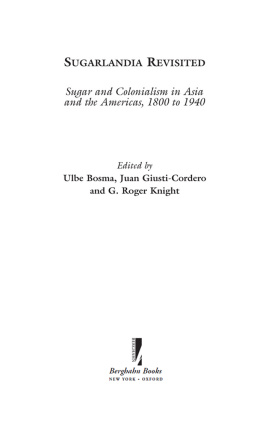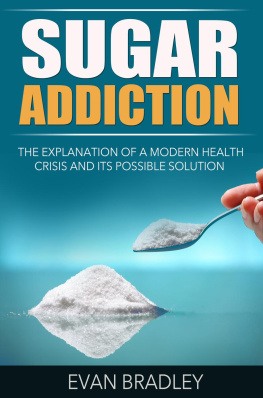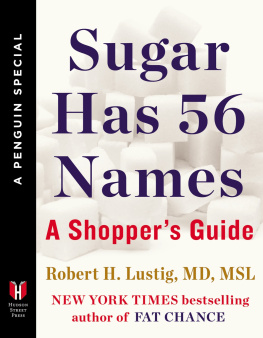Sugarlandia Revisited
International Studies in Social History
General Editor: Marcel van der Linden
International Institute of Social History, Amsterdam
Volume 1
Trade Unions, Immigration and Immigrants in Europe 19601993
Edited by Rinus Penninx and Judith Roosblad
Volume 2
Class and Other Identities
Edited by Lex Heerma van Voss and Marcel van der Linden
Volume 3
Rebellious Families
Edited by Jan Kok
Volume 4
Experiencing Wages
Edited by Peter Scholliers and Leonard Schwarz
Volume 5
The Imaginary Revolution
Michael Seidman
Volume 6
Revolution and Counterrevolution
Kevin Murphy
Volume 7
Miners and the State in the Ottoman Empire
Donald Quataert
Volume 8
Anarchism, Revolution and Reaction
Angel Smith
Volume 9
Sugarlandia Revisited
Edited by Ulbe Bosma, Juan Giusti-Cordero and G. Roger Knight
Volume 10
Alternative Exchanges
Edited by Laurence Fontaine
Volume 11
A Social History of Spanish Labour
Edited by Jose A. Piqueras and Vincent Sanz-Rozaten
Volume 12
Learning on the Shop Floor
Edited by Bert de Munch, Steven L. Kaplan and Hugo Soly
S UGARLANDIA R EVISITED
Sugar and Colonialism in Asia
and the Americas, 1800 to 1940
Edited by
Ulbe Bosma, Juan Giusti-Cordero
and G. Roger Knight
First published in 2007 by
Berghahn Books
www.berghahnbooks.com
2007, 2010 Ulbe Bosma, Juan Giusti-Cordero and G. Roger Knight
First ebook edition published in 2012
All rights reserved. Except for the quotation of short passages for the purposes of criticism and review, no part of this book may be reproduced in any form or by any means, electronic or mechanical, including photocopying, recording, or any information storage and retrieval system now known or to be invented, without written permission of the publisher.
Library of Congress Cataloging-in-Publication Data
/ edited by Ulbe Bosma, Juan Giusti-Cordero, and G. Roger Knight.
p. cm. -- (International Institute of Social History ; v. 9)
Includes bibliographical references and index.
ISBN 978-1-84545-316-9 (hbk) -- ISBN 978-1-84545-784-6 (pbk) -- ISBN 978-0-85745-242-9 (ebk)
1. Sugar trade--Indonesia--Java--History. 2. Sugar trade--Southeast Asia--History. 3. Sugar trade--West Indies--History. I. Bosma, Ulbe, 1962- II. Giusti-Cordero, Juan A. III. Knight, G. R.
HD9116.I53J356 2007
382.4136--dc22
2007012582
British Library Cataloguing in Publication Data
A catalogue record for this book is available from the British Library
Printed in the United States on acid-free paper
ISBN 978-1-84545-316-9 (hardback)
ISBN 978-1-84545-784-6 (paperback)
ISBN 978-0-85745-242-9 (ebook)
C ONTENTS
Sidney W. Mintz
Ulbe Bosma, Juan Giusti-Cordero and G. Roger Knight
G. Roger Knight
Arthur van Schaik and G. Roger Knight
Ulbe Bosma
Sri Margana
Joost Cot
Manuel Barcia
Jorge Ibarra
Juan Giusti-Cordero
1
I NTRODUCTION
Sidney W. Mintz
A book that breaks new ground in dealing with an old subject merits a simple introduction one that, minimally, does not obstruct the serious readers search for enlightenment. I shall try here to be simple, and brief.
A powerful and apparently innate human liking for the sweet taste, tied particularly though not exclusively to honey in the ancient world (as well as globally, among all peoples known to live among bees), was wholly transformed by the spread of crystalline sugar, processed from the juice of domesticated sugar cane, which began its diffusion from Southwest Asia, after about 300 BC . It was only several centuries later that sugar began to reach Europe in sizable quantities, both overland and via the Mediterranean. Following the Islamic conquest of Spain and Portugal, near the middle of the eighth century, sugar cane was also planted for the first time, and sugar made from it, on European soil, along Spains southern littoral. Although now only of minor economic importance, its cultivation has continued there for the last 1250 years.
By the fourteenth century, sucrose (crystalline or liquid C12H22011), won from sugar cane by heat and clarification, had become a coveted good in the West. Its consumption trajectory thereafter was ascendant, especially in Europe. It has begun to falter only in the last half-century or so; but it has continued to rise meanwhile in much of the so-called developing world, including Algeria, Egypt and Indonesia.
The chronology accompanying that trajectory can be broken down into different sorts of stages or epochs. But from nearly every perspective, the history of sugar up to now has been viewed as a triumph of New World production, resting from the outset on an abundance of fertile land and the labour of coerced peoples, especially African slaves. That American history began with Columbuss second voyage in 1493, which brought the plant to the island of Santo Domingo, and it has continued until present times. The epoch of slavery and the implantation of sugar factories in the New World colonies before 1500, and its sequels with free labour since, has dominated most historical inquiries about sugar, tending to set both the boundaries and the goals of research. But in truth, and in spite of the primacy of New World production, the growing of cane and the making of sugar in the world outside the Americas has long been enormously important and complexly differentiated. In spite of some important work (e.g., Sucheta Mazumdars for China, Donald Attwoods for India, Chih-Ming Kas for Taiwan, and that of many students of the Australian, Indian Ocean and Philippine industries), the number of historians of sugar that have shown as much interest in the Old World centres as in the New has been modest. Hence our vision of the global compass of sugar and of its later stages as a world industry has inclined towards being incomplete and simplistic. This book is an important initial step towards addressing that deficiency.
The New-World-centred history of sugar seems to have suffered from an additional shortcoming, linked to sugars New World beginnings as a largeestate, slave-based, field-and-factory industry in what were the Wests first overseas possessions. Inevitably, sugar, rum and molasses first became commodities for the Western world. The history of their production lent itself to convenient polarities of description large-scale production versus small; unified field-and-factory versus separated cultivation and processing; coerced labour versus free labour, and the like in the construction of historical portraits of the American centres of production. Each such contrast proved useful for building in broad terms a description of what happened with sugar in particular New World settings, such as Brazil, or in one or another of the various Caribbean sugar islands.












